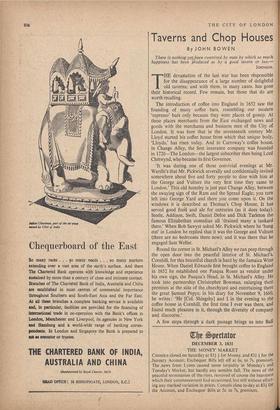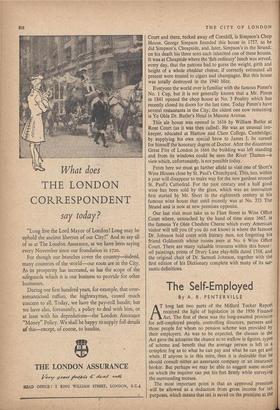Taverns and Chop Houses
By JOHN BOWEN There is nothing yet been contrived by man by which so much happiness has been produced as by a good tavern or inn.—
JOHNSON.
THE devastation of the last war has been responsible for the disappearance of a large number of delightful old taverns; and with them, in many cases, has gone their historical record. Few remain, but those that do are worth recalling.
The introduction of coffee into England in 1652 saw the founding of many coffee bars, resembling our modern `espresso' bars only because they were places of gossip. At these places merchants from the East exchanged news and goods with the merchants and business men of the City of London. It was here that in the seventeenth century Mr. Lloyd started his coffee house from which that unique body, `Lloyds,' has risen today. And in Carroway's coffee house, in Change Alley, the first insurance company was founded in 1720—The London—the largest subscriber then being. Lord Chetwynd, who became its first Governor.
'It was during one of those convivial evenings at Mr. Wardle's that Mr. Pickwick severally and confidentially invited somewhere about five and forty people to dine with him at the George and Vulture the very first time they came to London.' This old hostelry is just past Change Alley, between the swaying sign of the Ram and the Spread Eagle; you turn left into George Yard and there you come upon it. On the windows it is described as Thomas's Chop House. It has served good foOd and ale for centuries (as it does today). Steele, Addison, Swift, Daniel Defoe and Dick Tarleton the famous Elizabethan comedian all 'drained many a tankard there.' When Bob Sawyer asked Mr. Pickwick where he 'hung out' in London he replied that it was the George and Vulture (there are no bedrooms there now); and it was there that he engaged Sam Weller.
Round the corner in St. Michael's Alley we can peep through the open door into the peaceful interior of St. Michael's, Cornhill, for this beautiful church is hard by the Jamaica Wine House. When Daniel Edwards first brought coffee to England in 1652 he established one Pasqua Rosee as vendor under his own sign, the Pasqua's Head, in St. Michael's Alley. He took into partnership Christopher Bowman, enlarging their premises at the side of the churchyard and entertaining there the great Samuel Pepys; in his diary for November 9, 1660, he writes: 'He [Col. Shingsby] and I in the evening to the coffee house in Cornhill, the first time I ever was there, and found much pleasure in it, through the diversity of company and discourse.'
A few steps through a dark passage brings us into Ball Court and there, tucked away off Cornhill, is Simpson's Chop House. George Simpson founded this house in 1757, as he did Simpson's, Cheapside, and, later, Simpson's in the Strand; on his death his three sons each inherited one of these houses. It was at Cheapside where the 'fish ordinary' lunch was served, every day, that the patrons had to guess the weight, girth and height of a whole cheddar cheese; if correctly estimated all present were treated to cigars and champagne. But this house was totally destroyed in the 1940 blitz.
Everyone the world over is familiar with the famous Pimm's No. 1 Cup, but it is not generally known that a Mr. Pimm in 1841 opened the chop house at No. 3 Poultry which has recently closed its doors for the last time. Today Pimm's have several restaurants in the City; the oldest one now remaining is Ye Olde Dr. Butler's Head in Masons Avenue.
This ale house was opened in 1616 by William Butler at Rose Court (as it was then called). He was an unusual inn- keeper, educated at Harrow and Clare College, Cambridge; by supplying his own special brew to James I, he earned for himself the honorary degree of Doctor. After the disastrous Great Fire of London in 1666 the building was left standing and from its windows could be seen the River Thames—a view which, unfortunately, is not possible today.
From here we must go farther afield to visit one of Short's Wine Houses close by St. Paul's Churchyard. This, too, within a year will disappear to make way for the new gardens around St. Paul's Cathedral. For the past century and a half good wine has been sold by the glass, which was an innovation first started by Mr. Short in the eighteenth century at his famous wine house that until recently was at No. 333 The Strand and is now at new premises opposite.
Our last visit must take us to Fleet Street to Wine Office Court where, untouched by the hand of time since 1667, is the famous Ye Olde Cheshire Cheese which every American visitor will tell you (if you do not know) is where the famous Dr. Johnson held court with literary men, not forgetting his friend Goldsmith whose rooms were at No. 6 Wine Office Court. There are many valuable treasures within this house : oil paintings, prints of Drury Lane play-bills dated 1768, and the original chair of Dr. Samuel Johnson, together with the first edition of his Dictionary complete with many of its sar- castic definitions.



















































 Previous page
Previous page